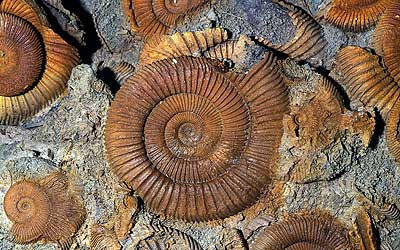Amazon recommendation: Field Guide to the Devonian Fossils of New York (paid link)

The body size of ancient creatures, bivalves and brachiopods, could tell geoscientists a lot about the creatures' life history and about the ecology of the times in which they lived. However, traveling the world to measure these creatures' fossils would take several life-times and more travel funds than scientists usually have.
Since the same creatures have also become abundant in scientific literature since the mid 1800s, a team of Virginia Tech researchers is determining whether measuring photos of fossils collected worldwide would be a reliable way to compile body size data. Richard A. Krause Jr. of Greenfield, Wisconsin, a PhD. student in the Department of Geosciences at Virginia Tech, reported on his assessment of this nontraditional approach at the joint meeting of the Northeastern and Southeastern Sections of the Geological Society of America, held March 25-27 in Tysons Corner, Virginia.
Bivalves (i.e. clams) are common today while brachiopods, which look like clams but have a different biology, were most common in ancient oceans. Both types of organism have been around for over 500 million years and still exist today, which makes them good subjects for an assessment of long-term body size trends. Changes in body size could reveal whether an organism evolved and became more efficient or whether environmental changes had an impact. "But no one has compiled a list of how body size changed for a group of animals over long time periods," Krause says. He and colleagues want to look at two time periods -- from 500 million to 300 million years ago and from 200 million to 25 million years ago.
"Since paleontology became a science, people have been publishing papers on new species from all over the world. With the advent of photography, authors began to provide volumes of photographic plates that document everything they thought was important about a species. If we could find a way to get size data from the photos, we could travel around the world simply by going to the library," says Krause.
But there were two big questions. Are the photos an accurate representation of size, and, were the specimens selected to be photographed actually representative of those collected?
Virgnia Tech professor of geosciences Michal Kowalewski addressed the first question by measuring brachiopods in photos and then measuring the actually specimens that were retained at museums. He reported, along with several colleagues, that the difference was negligible and was within the error range of the instruments used to take the measurements (Kowalewski et al., 2000).
Krause and colleagues have been researching the second question by examining the specimens field geologists originally shoveled into their collection boxes. They compared the range of sizes of the specimens in each box with those finally selected for the limelight in a scientific journal. "The author can't photograph every specimen due to space," says Krause. He went to museums to examine the boxed fossils originally collected for 41 species of brachiopods and 45 species of bivalves from a half-dozen countries.
"The distribution of those that were photographed were generally within the range we observed by measuring the collections," Krause says. However, authors did tend to pick more of the larger specimens to photograph than would have actually been representative, the Virginia Tech researchers discovered. "In both the bivalve and brachiopod samples, about one-third of the specimens photographed were in the top 10 percent of those collected in terms of size," says Krause.
"The taxonomic literature is biased," Krause says, "but it is biased in the same direction and roughly the same magnitude for both brachiopods and bivalves. So, we feel that the methodology of measuring photographs in the literature can be useful," says Krause, "although, it is still controversial. There are geoscientists who are not comfortable with this approach."
He and his colleagues will continue to double check the methodology as they collect large amounts of size data over the next several years. They expect that these data will help answer many important questions about the history of life, and it will probably spark some new ones as well.
Co authors of the paper, "Assessing the usefulness of literature-derived estimates of body size" are Krause, Virginia Tech graduate student Jennifer Stempien, Kowalewski, and Arnold Miller of the Department of Geology at the University of Cincinnati.